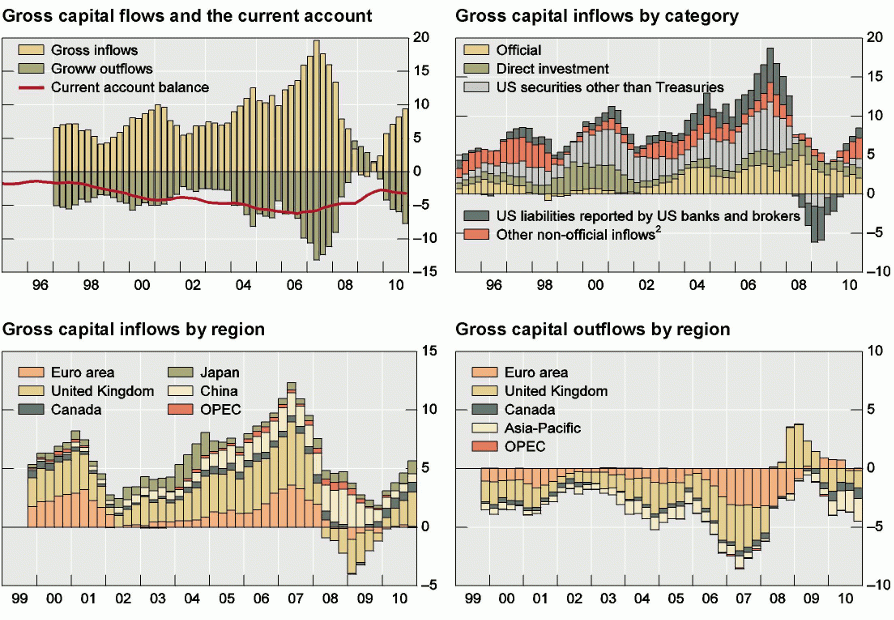Global current-account imbalances have been at the forefront of policy debates. In the wake of the financial crisis, many observers and policymakers have singled them out as a key factor contributing to the turmoil (Bernanke 2009, Economist 2009, King 2010, Krugman 2009, and Portes 2009). A prominent view is that an excess of saving over investment in emerging market countries, as reflected in corresponding current-account surpluses, eased financial conditions in deficit countries and exerted significant downward pressure on world interest rates. As a result, this flow of saving helped fuel a credit boom and risk-taking in major advanced economies, particularly in the US, thereby sowing the seeds of the global financial crisis.
In a recent paper (Borio and Disyatat 2011), we argue that such a view, with its focus on saving-investment balances, current accounts and net capital flows, calls for reconsideration.1 Our objections centre on two main elements: the presumption that (i) net capital flows from current-account surplus countries to deficit nations helped finance credit booms there and that (ii) a rise in saving relative to investment in surplus countries depressed world interest rates, particularly those on dollar assets, in which much of the surpluses are seen to have been invested.
Objection 1: Global imbalances reveal little about global financing patterns
Current accounts and net capital flows reveal little about financing. They capture changes in net claims on a country arising from trade in real goods and services and hence net resource flows. But they exclude the much larger changes in gross flows and their contributions to existing stocks, including all the transactions involving only trade in financial assets, which make up the bulk of cross-border financial activity. As such, current accounts tell us little about the role a country plays in international borrowing, lending and financial intermediation, about the degree to which its investment expenditures are financed from abroad, and about the impact of cross-border capital flows on domestic financial conditions.
Shifting the focus from net to gross capital flows casts doubt on the view that global current-account imbalances played a critical role in the crisis.
First, the bulk of the spectacular expansion of global gross capital flows (inflows plus outflows) since the late 1990s, from around 10% of world GDP in 1998 to over 30% in 2007, has been driven by flows between advanced economies. Flows from, or, between, emerging markets have been much smaller.
Figure 1. US balance of payments (As a percentage of US GDP)
Notes: 1 4-quarter moving average. 2 Sum of US Treasury securities, foreign assets in US dollar and US liabilities to unaffiliated foreigners.
Sources: Bureau of Economic Analysis; authors’ calculations.
Second, current accounts did not play a dominant role in determining financial flows into the US in the run-up to the crisis. Gross capital flows into and out of the US expanded roughly three times faster than net claims (Figure 1, top left-hand panel).
Third, while discussions of global imbalances have stressed the role of the official sector, the bulk of gross inflows into the US originated in the private sector (Figure 1, top right-hand panel). This reflected the rapid rise in foreign purchases of US securities and in US banks’ liabilities to non-residents between 2000 and 2007, a telling sign of the strong global financial boom which saw the US at its epicentre.
Fourth, by far the largest source of capital inflows into the country was Europe, not emerging markets (Figure 1, bottom left-hand panel). Europe accounted for around one-half of total inflows in 2007. Of this, more than half came from the UK, a country running a current-account deficit, and roughly one-third from the Eurozone, a region roughly in balance. This amount alone exceeded that from China and by an even larger margin that from Japan, two large surplus economies. US gross outflows show a similar pattern, with outflows into Europe accounting for an even larger share compared to inflows (Figure 1, bottom right-hand panel).
Fifth, net capital flows do not capture the severe disruption in cross-border interbank lending nor do they correctly predict the source of strains. Global current-account imbalances narrowed only slightly in 2008. By contrast, gross capital flows collapsed, driven predominantly by retrenchment in flows between advanced economies. For the US, net capital inflows fell by a mere $20 billion during 2008, while gross inflows decreased by no less than $1.6 trillion – roughly a 75% decline from their 2007 level. Much of the drop reflected gross flows between the US and Europe.
On balance, the picture that emerges is strikingly different from the stylised one associated with the excess-saving view. Asia plays little role in the financing of the credit boom in the US; Europe, and in particular European banks, take centre stage. Official holdings of US Treasury securities by the countries accumulating foreign-exchange reserves hardly figured in the turmoil. And the trigger for the crisis, as well as the channel for its propagation, was not a disorderly unwinding of global imbalances, but dislocations in the chain of global intermediation.
Saving is not financing
The failure to distinguish between gross and net capital flows is a manifestation of the broader failure to distinguish sufficiently clearly between saving and financing. Saving, a national-accounts concept, is simply income (output) not consumed. Financing, a cash-flow concept, is access to purchasing power in the form of an accepted settlement medium (money), including through borrowing. Investment, and expenditures more generally, require financing, not saving. And it is only once expenditures take place that income, investment, and hence saving, materialise.
A number of implications follow.
First, the change in financial assets and liabilities in any given period bears little relationship to saving (and investment) in the national accounts sense. In practice, increases in assets and liabilities typically greatly exceed saving in any given period. This reflects the myriad of ways in which expenditures, including on pre-existing assets, are financed. It also translates into cross-border gross flows that are typically much larger than net ones.
Second, an economy running a balanced current account (so that saving equals investment) can actually be engaged in substantial cross-border intermediation and the whole of its investment expenditures may even be financed from abroad.
Third, countries running current-account surpluses are not financing those running current-account deficits. The underlying consumption and investment expenditures that generate those positions may be financed in a myriad of ways, both domestically and externally. True, by exchanging financial claims for goods and services, the deficit country is effectively, on a net basis, “borrowing” from, or drawing down assets on, the rest of the world. But the ultimate counterpart of changes in those claims need not be countries running current-account surpluses. If, say, country A has a deficit with country B, it does not follow that it has accumulated liabilities to B. These liabilities may be held by any country in the world.2
Objection 2: Saving-investment balances do not directly determine m
arket interest rates
Our second main objection to the excess-saving view is that a “saving glut” is an incomplete explanation of low interest rates. Here again, the distinction between saving and financing is critical. Market interest rates reflect monetary and financial factors. They result from the interplay between the policy rate set by central banks, market expectations about future policy rates and risk premia, which, in turn, are influenced by relative supplies of financial assets and economic agents’ risk perceptions and preferences. Here, it is stocks rather than flows that matter most. Agents should be willing to hold the whole stock of assets. By contrast, the excess-saving view explains interest rates through flows of expenditures underpinned by purely real factors, in the form of saving and investment propensities. Being just a description of the real side of the economy, the saving-investment framework is best seen as determining a notional “natural”, equilibrium rate, to which the economy may gravitate in the long run.
While it is possible that the market rate may trend towards the natural rate over any given period, we argue that this was not the case before the financial crisis. We see the unsustainable expansion in credit and asset prices that preceded it as a sign of a significant and persistent gap between the two rates, even if inflation remained low and stable. Moreover, since by definition the natural rate is an equilibrium phenomenon, it is hard to see how market rates roughly in line with it could have been at the origin of the financial crisis. In other words, central banks and market participants kept interest rates too low relative to their equilibrium levels.3 This was one of the factors contributing to the turmoil.
The international monetary and financial system needs stronger anchors
Global imbalances have little to say about the patterns of global intermediation behind the credit boom and the transmission of the turmoil or about the determination of market interest rates. They divert attention away from the monetary and financial factors that sowed the seeds of the crisis. In promoting global financial stability, policies that address current-account imbalances cannot be the priority. Directly addressing the weaknesses in the international monetary and financial system is more important. Our key hypothesis is that the international monetary and financial system lacks sufficiently strong anchors to prevent unsustainable credit and asset booms, resulting in what we call “excess elasticity”. Reducing this elasticity requires stronger anchors in the financial and monetary regimes, underpinned by prudent fiscal policies.
The views expressed are those of the authors and do not necessarily represent those of the Bank for International Settlements or the Bank of Thailand.
References
Bernanke, B (2009), “Financial reform to address systemic risk”, Speech at the Council on Foreign Relations, Washington DC, 10 March.
Borio, C and P Disyatat (2011), “Global imbalances and the financial crisis: Link or no link?”, BIS Working Papers 346, May.
Economist, The (2009), “When a flow becomes a flood”, 22 January.
Feldstein, M and C Horioka (1980), “Domestic saving and international capital flows”, Economic Journal, 90:314-329.
King, M (2010), Speech delivered to the University of Exeter Business Leaders’ Forum, 19 January.
Krugman, P (2009), “Revenge of the glut”, The New York Times, 1 March.
Lucas, RE (1990), “Why doesn’t capital flow from rich to poor countries?”, American Economic Review, 80(May):92-96.
Portes, R (2009), “Global imbalances” , in M Dewatripont, X Freixas, and R Portes (eds.), Macroeconomic stability and financial regulation: Key issues for the G20, Centre for Economic Policy Research.
Shin, H (2009), “Global imbalances, twin crises and the financial stability role of monetary policy”, Paper prepared for the KIEP/CEPR conference, The World Economy with the G20, Seoul, 20 November.
Truman, E (2009), “Lessons from the global economic and financial crisis”, Keynote Address, at the conference G20 reform initiatives: Implications for the future of regulation, co-hosted by the Institute for Global Economics and the IMF, Seoul, Korea, 11 November.
1 Other analyses playing down heavily the role of global imbalances include Shin (2009) and Truman (2009).
2 This point has important implications also for two well-known puzzles in international finance: capital flowing “perversely” from emerging to advanced economies (Lucas 1990) and the close match between saving and investment within national borders despite capital mobility (the Feldstein-Horioka 1980 puzzle). See our paper for a further discussion.
3 The failures to distinguish sufficiently clearly between saving and financing and between market and natural interest rates point to a common feature of prevailing economic analysis. That is, applying a form of real analysis, better suited to barter economies with frictionless trades, to a monetary economy, especially one in which credit creation takes place. In such a world, there is no distinction between these concepts. It is doubtful that an analysis ultimately rooted in the assumption that money and credit are veils of no consequence for economy activity can be adequate in understanding global financial intermediation, the determination of market interest rates and, as a result, financial instability.




